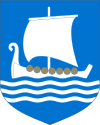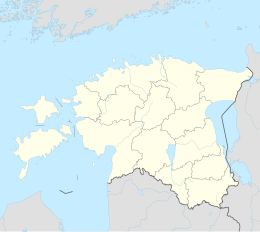Saaremaa
 |
|
| Geography | |
|---|---|
| Location | Baltic Sea |
| Coordinates | 58°25′N 22°30′E / 58.417°N 22.500°ECoordinates: 58°25′N 22°30′E / 58.417°N 22.500°E |
| Archipelago | West Estonian archipelago |
| Area | 2,673 km2 (1,032 sq mi) |
| Administration | |
| State | Saare County |
| Demographics | |
| Population | 30,966 (2013) |
| Pop. density | 11.6 /km2 (30 /sq mi) |
Saaremaa (Estonian pronunciation: [ˈsɑːremɑː]; Danish: Øsel; English (esp. traditionally): Osel; Finnish: Saarenmaa; Swedish & German: Ösel) is the largest island in Estonia, measuring 2,673 km2 (1,032 sq mi). The main island of Saare County, it is located in the Baltic Sea, south of Hiiumaa island, and belongs to the West Estonian Archipelago. The capital of the island is Kuressaare, which has about 15,000 inhabitants; the whole island has over 30,966 inhabitants.
The island is called Saaremaa in Estonian, and in Finnish Saarenmaa — literally "isle land" or "island land". In old Scandinavian sagas, Saaremaa is called Eysysla and in the Icelandic Sagas Eysýsla, which means exactly the same as the name of the island in Estonian: "the district (land) of island". This is the origin of the island's name in Danish Øsel, German and Swedish, Ösel, Gutnish Oysl, and in Latin, Osilia. The name Eysysla appears sometimes together with Adalsysla, "the big land", perhaps 'Suuremaa' or 'Suur Maa' in Estonian, which refers to mainland Estonia. In Latvian, the island is called Sāmsala, which means "the island of Saami".
According to archaeological finds, the territory of Saaremaa has been inhabited from at least 5,000 years BCE. Pre-Viking age Salme ships burial have been found in Sõrve Peninsula. Sagas talk about numerous skirmishes between islanders and Vikings. Saaremaa was the wealthiest county of ancient Estonia and the home of notorious Estonian pirates, sometimes called the Eastern Vikings. The Chronicle of Henry of Livonia describes a fleet of sixteen ships and five hundred Osilians ravaging the area that is now southern Sweden, then belonging to Denmark. In 1206, King Valdemar II of Denmark built a fortress on the island but found no volunteers to man it. The Danes burned it themselves and left.
...
Wikipedia

